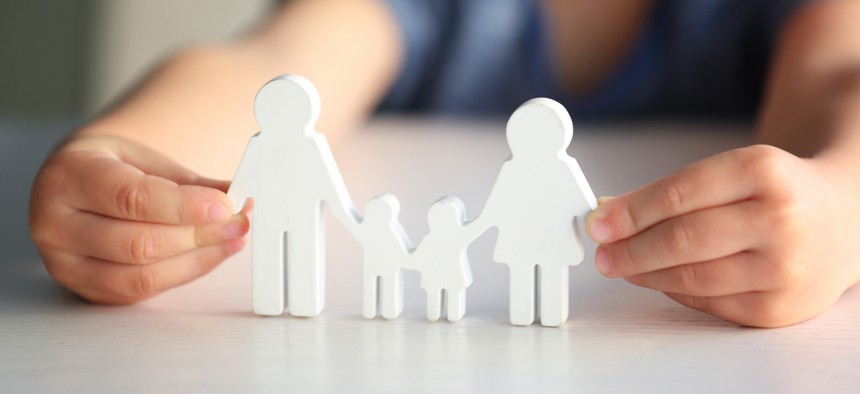A Foster Care and Adoption Shift in a Southern State

The state promotes "permanency" for children in foster care, which can mean adoption or reunification with biological parents or other families. Shutterstock

Connecting state and local government leaders
Louisiana refocused its efforts on foster care and adoption four years ago. Today, adoption rates are up, particularly among sibling groups and older teens.
Children often enter the foster care system with little warning, so they frequently show up to their temporary homes with no belongings—no toothbrush, no pajamas, nothing to get through that first uncertain night.
But in southern Louisiana, those initial needs are covered. In the Lafayette region, home to eight parishes, every office of the state Department of Children and Family Services is stocked with “first night” bags: reusable duffels filled with hygiene products, pajamas, socks and underwear, for both genders, in sizes ranging from preemie to adult XL.
“That way, when a child enters foster care, they can arrive at their new home with something that belongs to them and with their basic hygiene and clothing needs met for that first night,” said Heather Duhon, co-founder and executive director of Foster the Love Louisiana, a nonprofit organization that provides help and resources, including the bags, to foster families. “But, mainly, they get to show up with something that belongs to them.”
Duhon’s nonprofit is one of dozens in the state’s Louisiana Fosters program, a network of government agencies and faith, nonprofit, business and community organizations that work together to “create united support” for children and families in the foster care system.
The foster care program is part of a statewide campaign that is largely focused on “permanency” for children in the child welfare system, which can mean reunification with biological parents, placement with family members, or adoption, said Rhenda Hodnett, assistant secretary of child welfare for the Louisiana Department of Children and Family Services.
“It has always been a focus on permanency for kids,” she said. “Increased adoption numbers are a natural outcome of that, in many ways, but so is reunification, and we’ve seen increases in both areas.”
Adoptions have grown in Louisiana in recent years. According to data from the state, 893 children were adopted during the 2019 fiscal year, falling just short of the record 912 adoptions set in the previous fiscal year.
The department also saw a 22 percent increase in the number of teens adopted, rising from 68 teens adopted in the 2018 fiscal year to 83 in 2019. Sibling adoptions were also up. About 23 percent of adopting families last year adopted siblings, increasing to 24.8 percent this year. The state has focused extra resources on promoting adoption of those two groups of children, Hodnett said, so those metrics were particularly encouraging for state officials.
“Four years ago we recommitted to making sure that youth had permanency and that no youth aged out of our system without a permanent connection,” Hodnett said. “It’s been a combined effort of many, many things and many, many people that is starting to pay off now. A major factor was extending the age of foster care for those that were not able to transition to a family before they turn 18.”
That change, signed into law by Gov. John Bel Edwards in June, gives 18-year-olds the option to extend their foster care services until the age of 21. That can prevent children from “aging out” of the foster care system without finding permanent homes, an outcome that has been linked to higher rates of homelessness, unemployment and early pregnancy, among other things.
“There is no age at which people don’t feel that desire or have that longing to have a family that they know is permanent, is always there for them, and that they truly belong to as opposed to someone who is available for them to call,” Hodnett said. “That’s a big, big difference. All people want a sense of belonging.”
Other state efforts include a quality parenting initiative that helps foster and biological parents work together to determine the best outcome for each child. That process starts by introducing the child’s biological parent to the foster parent shortly after the child is taken into custody, then beginning a working relationship with the help of a caseworker. It’s a sort of co-parenting, which may seem counterintuitive, Hodnett said, but has proven successful in Louisiana.
“It’s entirely focused on the child, and it is often the real start of a trusting relationship and, often, a mentoring relationship, between the biological parent and the foster parent,” she said. “We hear over and over, if the parent cannot get it together, they are often grateful to know that there is a foster parent there who is interested and committed and willing to assume that responsibility.”
In addition to increased adoption rates, the separate initiatives have helped shift community views of the foster care system, Duhon said.
“The whole state is kind of working on it, and there has been a mindset shift with that,” she said. "As communities, we’re talking about it more than it has been in a long time, and I think that just comes down to knowing that as a whole, the state is doing more work in this department than they have in a long time.”
Kate Elizabeth Queram is a Staff Correspondent for Route Fifty and is based in Washington, D.C.

NEXT STORY: South Carolina Becomes First Non-Medicaid Expansion State to Enact Work Requirements




